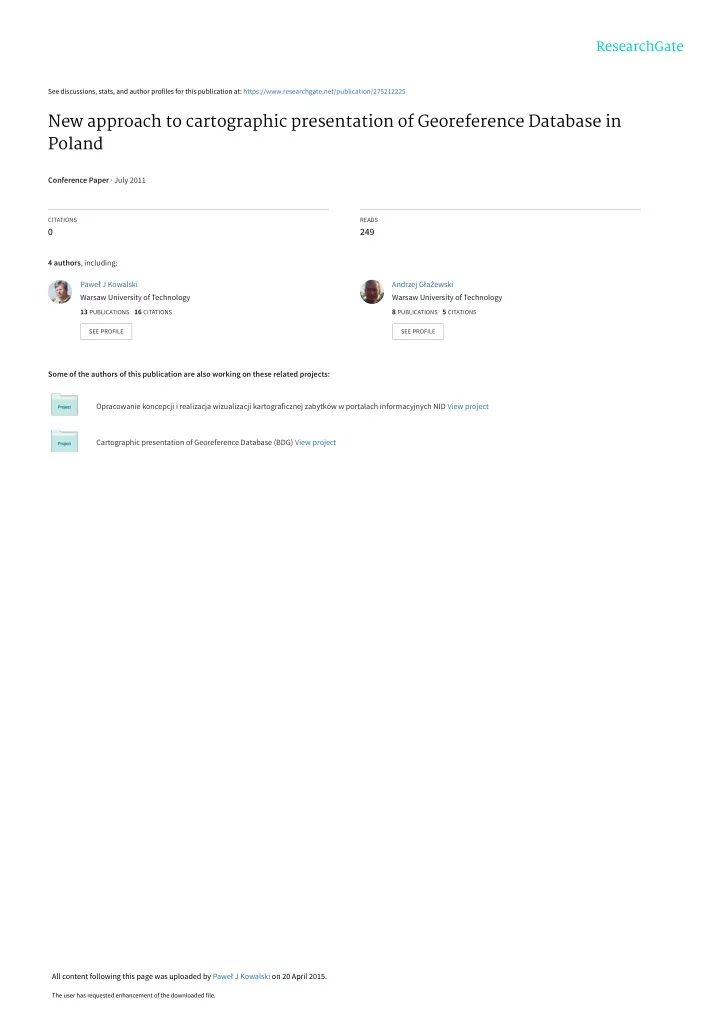

See discussions, stats, and author profiles for this publication at: https://www.researchgate.net/publication/275212225 New approach to cartographic presentation of Georeference Database in Poland Conference Paper · July 2011 CITATIONS READS 0 249 4 authors , including: Pawe ł J Kowalski Andrzej G ł a ż ewski Warsaw University of Technology Warsaw University of Technology 13 PUBLICATIONS 16 CITATIONS 8 PUBLICATIONS 5 CITATIONS SEE PROFILE SEE PROFILE Some of the authors of this publication are also working on these related projects: Opracowanie koncepcji i realizacja wizualizacji kartograficznej zabytków w portalach informacyjnych NID View project Cartographic presentation of Georeference Database (BDG) View project All content following this page was uploaded by Pawe ł J Kowalski on 20 April 2015. The user has requested enhancement of the downloaded file.
CO-420 NEW APPROACH TO CARTOGRAPHIC PRESENTATION OF GEOREFERENCE DATABASE IN POLAND OSTROWSKI W.(1), ANDRZEJEWSKA M.(2), GłAżEWSKI A.(3), KOWALSKI P.(3) (1) Warsaw University, WARSZAWA, POLAND ; (2) UNEP/GRID-Warszawa, WARSZAWA, POLAND ; (3) Warsaw University of Technology, WARSZAWA, POLAND 1. INTRODUCTION The Directive 2007/2/EC resolved on March 14, 2007 , which defines INSPIRE, the European Spatial Data Infrastructure requires that spatial data are commonly created by public institutions of the European Union countries. Every member state is obliged to establish its own legal acts, introducing the assumptions of the INSPIRE Directive. In Poland, the team of experts was established in the beginning of 2009 at the Head Office of Geodesy and Cartography; its task was to prepare the draft Decree of the Minister of the Interior and Administration (MSWiA), concerning the data base of topographic and general geographical objects, and cartographic works. It is to be one of 12 administrative decrees to the Act on spatial information infrastructure of March 4, 2010 – the legal act which implements the INSPIRE Directive resolutions in Poland. The discussed Decree of the MSWiA specifies the method of creation, updating and distribution of the Georeference Data Base (BDG), which is based on an integrated model of topographic and general geographic data bases. That data base will allow to make general geographic maps in the entire scale series. TOPO10 component is to be the source of data for topographic maps at the scales of: 1:10 000, 1:25 000, 1:50 000 and 1:100 000 for general works, at the scales: 1:250 000, 1:500 000 and 1:1 000 000 TOPO250 component will be used, being a set of generalised spatial data, stored in a unified data structure. The basic issue related to cartographic presentation of BDG data was to design a coherent system of symbols and the content range, graphical layout and elements of cartographic grids for maps, which would create the complete scale series of topographic and general-and-topographic maps in the history of Polish cartography. The idea concerning the range of content presented on maps, as well as graphical solutions in particular scales was based on traditions of the Polish topographic cartography, first of all on civil topographic maps produced at the scales 1:10 000 and 1:50 000 and general maps, edited from the General Geographical Data Base. However, editing assumptions of new maps also considered contemporary technological achievements of data bases, geographic information systems and map production systems. Three important practical assumptions have been made. Firstly, the BDG was to be the only data source for all cartographic works, with the exception for the terrain relief elements, which were to be acquired from the Digital Terrain Model. The second important assumption, which influences the selection of content and form of maps was to achieve the complete automation of the possibly maximum number of tasks, performed at the stage of data generalisation and visualisation. The third factor was the intention to adapt the content and layouts of maps to the users’ needs and expectations, with consideration of various applications, such as supplying the map services of the official geoportal. 2. STATUS OF TOPOGRAPHIC CARTOGRAPHY IN POLAND The characteristic feature of the current status of topographic cartography in Poland is the lack of uniformity of maps produced at various scales; this refers to the reference system, division into map sheets, substantial and graphic concepts and the level of updating. It results from many purposes, the most important of which concerned political conditions existing before 1990, and, in particular, subordination of topographic - civil and military – cartography to limitations and restrictions related to the Polish membership in the Military Warsaw Pact. As a result of those limitations, not only military maps, but also civil maps, which were to be used for economic purposes, were not accessible for individual users, they were classified as „secret” and they could be used by authorised institutions and state offices. But, in order to allow for even such level of distribution of civil topographic maps, in the course of producing those civil maps basing on military maps, they had to be transformed from the secret „1942” co -ordinate system to specially developed co- ordinate systems, such as: „1965” (stereographic, secant projection) for maps 125 000 and 1:50 000 and the system 1980 (quasi-stereographic projection) for the maps 1:100 000. Besides, Polish military and derivative civil topographic maps published in the period 1953 – 1990 were made basing on the Soviet instructions for military map production, which were obligatory in all Warsaw Pact member states.
Recommend
More recommend